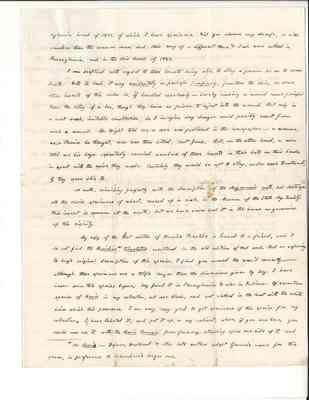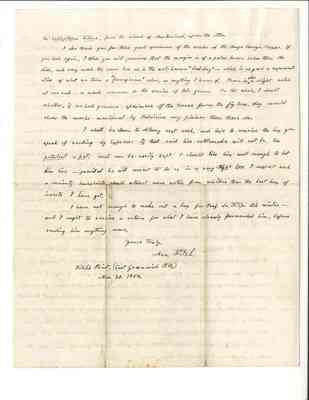Pages
1
Fitchs Point Nov 10th 1854 Robt W. Kennicott Esq. My dear Sir:- Yours of the 5th just is recieved before your previous one of Oct. 22d is answered. I fear you will find me rather a negligent correspondent. I never enter my study in the morning but that some insect is in my mind, which I am eager to take up and examine; and the examination of this one is sure to bring to my notice one, two or more others to be attended to next; and I am impatient of anything which draws me off from this employment. And when the mail brings in to me a half dozen letters at a time, as it often does, my patience holds out only long enough to reply to those which demand immediate attention - the others are laid aside, to a more leisure hour - which leisure hour not arriving, weeks frequently pass by before I make out to reply, in those cases in which I have nothing of special importance to communicate. Nay, I sometimes forget these favors of a friend altogether, until another missive from the same source recalls him to my mind afresh. A gentleman with whom I fell in company on a steamboat on L. Michigan gave me a full account of the observations he had made upon the Seventeen-year Locust - including the fact that the female makes two parallel slits in which to deposit her eggs. But the fact mentioned in your last letter is new to me - that the twig thus wounded, does not always wither and fall to the ground. Such twigs as are still alive in your vicinity, it must be, will recover from the wounds they received - as the eggs being all hatched, there will be no further invilation there, to prevent a recovery. I presume it is those twigs which had the fewest wounds, which have thus survived. The wounds, I suppose, are still plainly perceptible. If so, I should be glad to have you send me pieces of two or three Twigs (from the apple tree especially) showing these wounds. You can enclose them in a newspaper, by mail. As I shall give some account of this species in my forthcoming Report, and as you have had, I suppose, good opportunities for examining
2
it, I should like to receive from you all the facts respecting this insect, which are within your knowledge, and particularly any which are not mentioned fully in Dr. Harris's Treatise. None of these insects ever come out in my neighborhood, and I consequently know little about them from personal observation. By digging along the roots of trees the twigs of which were much infested last time, you can doubtless now find the young larvae. If you should do so, please send me 3 or 4 specimens in a quill, for my cabinet and that of the State Agric. Society. And if you can find the worm readily [underlined], it would be well to keep an eye upon it, year after year, and notice its increase in size, the depth at which it resides at different time, &c. you would, doubtless, thus find out much that is interesting, and when it appears again, you would be able to give a full and complete history of this world-famous species - such a history as will connect your name with it in all coming time. The first notice we have of this insect - that of Rev. A. Sandel, Philadelphia, 1715 - says, "They issued from the earth everywhere, even on the hard roads." And a gentleman, west, told me he had noticed their holes and empty shells in the middle of a beaten road. But, unless there are roots of trees running under the road, it is difficult to conceive what the larvae could find to subsist upon in such a situation. And if, where the larvae now are, the land should be cleared of its timber, so that the roots all perish,-would the larvae die? or make their way through the ground to other situations? Do you know if any insects emerged in spots where the timber had been cleared off one, two, or more years ago? It is truly wonderful, that in so many years, some individuals, happening where they have an abundance of nourishment, do not get their growth and come out a year sooner - or that others are not started, so as to be a year later in appearing. Watch closely next June, and see if you cannot find here and there a scattering individual. If you saved any spare specimens, I should be glad to receive them, to see if they do not vary in some minute particular from the Hudson river brood of 1843 or the Penn-
3
sylvania brood of 1851, of which I have specimens. Did you observe any dwarfs, a size smaller than the common ones, and their song of a different tone? Such were noticed in Pennsylvania, and in the Ohio brood of 1846. I was sceptical with regard to these locusts being able to sting a person so as to cause death. With its beak, it may accidentally [underlined] or perhaps purposely, puncture the skin, as some other insects of this order do, if handled carelessly - hereby causing a wound more painful than the sting of a bee, though they have no poisen to inject into the wound. But only in a most weak, irritable constitution, do I imagine any danger could possibly result from such a wound. Mr. Wight told me a case was published in the newspapers - a woman, near Peoria he thought, who was thus killed, last June. But, on the other hand, a man told me his boys repeatedly carried numbers of these locusts in their hats on their heads, in sport with the noise they made. Certainly they would be apt to sting, under such treatment, if they were able to. A moth, coinciding perfectly with the description of the Angoumois moth, has destroyed all the choice specimens of wheat, corked up in vials, in the Museum of the State Ag. Society. This insect is common at the south; but we have never had it in the barns or granaries of this vicinity. My copy of the last edition of Harris's Treatise is loaned to a friend, and I do not find the Baridius * trinotatus mentioned in the old edition of that work. But on referring to Say's original description of this species, I find you named the weevil correctly. - although these specimens are a trifle longer than the dimensions given by Say, I have never seen this species before. Say found it in Pennsylvania & also in Indiana. Of seventeen species of Baris in my collection, all are black, and not clothed in the least with the white hairs which this possesses. I am very, very glad to get specimens of this species for my collection. I have ticketed it, and put it up, in my cabinet, where, if you was here, you could now see it with the Baris Furaxici from Germany, standing upon one side of it, and [short line drawn above] * Or Baris - Dejean, Westwood & other late writers adopt Germar's name for this genus, in preference to Schonberr's longer one.
4
the Scolopterus bidens, from the island of New Zealand, upon the other. I also thank you for three good specimens of the scales of the Osage Orange Coccus. If you look again, I think you will perceive that the margin is of a paler brown color than the disk, and very much the same hue as is the well-known "bed-bug"- which is as good a representative of what we term a "ferruginous" color, as anything I know of. There is also a slight notch at one end - a mark common to the species of this genus. On the whole, I doubt whether, if we had genuine specimens of the Coccus from the fig tree, they would show the marks mentioned by Fabricius any plainer than these do. I shall be down to Albany next week, and hope to receive the box you speak of sending by Express. If that said live rattlesnake will not be too petulent a pet, and can be easily kept, I should like him well enough to let him live - provided he will consent to do so in a very tight box. I suspect such a curiosity hereabouts would attract more notice from visitors than the best box of insects I have got. I have not enough to make out a box for Prof. de Filipi this winter - and I ought to receive a return for what I have already forwarded him, before sending him anything more. Yours Truly, Asa Fitch. Fitch's Point, (East Greenwich P.O.) Nov, 20. 1854.



